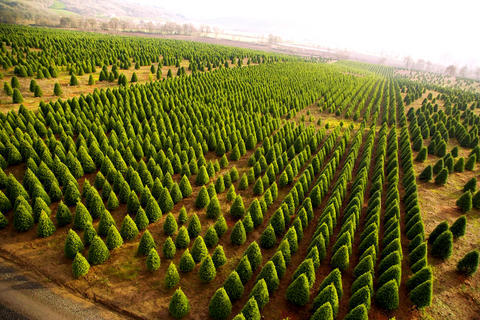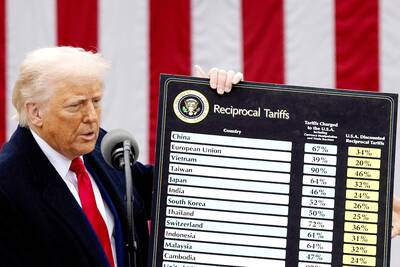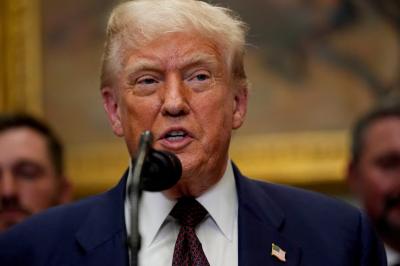A battle is being waged for the heart of the US Christmas tree customer, pitting the real evergreen against the once-lowly artificial tree.
Last year, an estimated 9.3 million artificial trees were sold in the US, up 2 million from five years ago. And while the real tree harvest was triple that, the numbers are of major concern for growers because artificial trees can be used year after year.
It has reached a point where half the trees put up in US households are made of plastic, industry watchers say. The rest of the bad news for growers is that it is getting harder to tell which trees are real.

PHOTO: NY TIMES NEWS SERVICE
China produces a vast majority of the artificial trees, which has tree growers preaching the gospel of "buy natural, buy American" in an effort to fend off claims by the artificial camp that cutting down trees is an environmental travesty.
"It's important to dispel the myth that cutting Christmas trees causes deforestation," said John Schuler, whose family owns Holiday Tree Farms in Corvallis. "It's a crop, just like corn."
The artificial-tree camp, meanwhile, claims that growers have resorted to scare tactics, warning about lead in the manufactured products while playing down the use of pesticides on the tree farms.
This year, the National Christmas Tree Association prepared a point-by-point chart comparing real and plastic trees.
"It's an attempt to make it a simple apples-to-apples comparison," said Rick Dungey of the tree group, based in Missouri. "Once you see the difference, it becomes a pretty clear choice."
Not so, said Thomas Harman of Balsam Hill Trees, a high-end artificial tree company that prides itself on being able to pass off its creations as the real thing. Harman said the bottom line was whether customers want convenience over the real thing
"The main advantage of an artificial tree is that you can put it up before Thanksgiving and put it away after New Year's," Harman said. "You never have to deal with needles or sap."
Whatever the case, the number of artificial trees continues to grow and sales of real trees have been flat in recent years.
But in the long view, plastic versus natural is just another chapter in the Christmas tree's rich history.
First popularized by the Germans, the Christmas tree has taken on some unusual looks, including being hung from the rafters with an apple attached to a sharpened tree butt. The Germans brought their tradition to the New World, but it was hardly quick to catch on, given the strong influence of Puritanism.
Among the first to see there was money to be made was a New Yorker named Mark Carr, who in 1851 filled two ox sleds with evergreens from the Catskills, loaded them on a steamboat and took them 110km to New York City. By 1880, more than 200,000 trees were being shipped to New York each year.
In 1955, Hal Schudel, the founder of Holiday Tree Farms, now perhaps the world's largest Christmas tree grower, began harvesting trees in the Willamette Valley as a way of supplementing his income as an agronomist at Oregon State University.
This year, Holiday will harvest more than 1 million trees, so the pace is frenetic at staging areas here, about 25km west of Salem and all over the valley. Kyle Gunsauls has been jockeying his helicopter from dawn to dusk, dropping just-cut trees from Holiday's lots into waiting trucks before racing back for more.
"No one wants a tree the day after Christmas," Gunsauls said.
Containers to the Philippines, Japan and Pago Pago are long gone, but many orders, most from California, remain.
"It's like getting a freight train moving," said Eugene Carson, who has overseen Holiday shipments for 27 years. "Everything has to be in sync."
That's true all over the country. About 182,000 hectares of land in the US are devoted to growing Christmas trees.
Operations range from megagrowers like Holiday to mom and pop farms in all 50 states. Last year's harvest of 28.6 million trees had a retail value of US$1.2 billion.
Now, the back country roads here are filled with thousands of hectares of trees. An independent grower, Jan Hupp, was harvesting at his farms near Drakes Crossing, a dot in the road in the heart of Christmas tree country.
Hupp drove past a 2 hectare plot where more than 2 million of his seedlings were growing, then on to fields with row after row of perfectly trimmed firs. Talk turned to how the area had once produced strawberries, then grass seed and, finally, Christmas trees. And with talk of trees came the inevitable mention of the artificial competition. Like other growers, Hupp can barely suppress his disdain.
"You can have a natural product or a petroleum-based product in your house," he said. "Are you going to send your wife plastic flowers or fresh-cut roses?"

WAITING GAME: The US has so far only offered a ‘best rate tariff,’ which officials assume is about 15 percent, the same as Japan, a person familiar with the matter said Taiwan and the US have completed “technical consultations” regarding tariffs and a finalized rate is expected to be released soon, Executive Yuan spokeswoman Michelle Lee (李慧芝) told a news conference yesterday, as a 90-day pause on US President Donald Trump’s “reciprocal” tariffs is set to expire today. The two countries have reached a “certain degree of consensus” on issues such as tariffs, nontariff trade barriers, trade facilitation, supply chain resilience and economic security, Lee said. They also discussed opportunities for cooperation, investment and procurement, she said. A joint statement is still being negotiated and would be released once the US government has made

NEW GEAR: On top of the new Tien Kung IV air defense missiles, the military is expected to place orders for a new combat vehicle next year for delivery in 2028 Mass production of Tien Kung IV (Sky Bow IV) missiles is expected to start next year, with plans to order 122 pods, the Ministry of National Defense’s (MND) latest list of regulated military material showed. The document said that the armed forces would obtain 46 pods of the air defense missiles next year and 76 pods the year after that. The Tien Kung IV is designed to intercept cruise missiles and ballistic missiles to an altitude of 70km, compared with the 60km maximum altitude achieved by the Missile Segment Enhancement variant of PAC-3 systems. A defense source said yesterday that the number of

Taiwanese exports to the US are to be subject to a 20 percent tariff starting on Thursday next week, according to an executive order signed by US President Donald Trump yesterday. The 20 percent levy was the same as the tariffs imposed on Vietnam, Sri Lanka and Bangladesh by Trump. It was higher than the tariffs imposed on Japan, South Korea and the EU (15 percent), as well as those on the Philippines (19 percent). A Taiwan official with knowledge of the matter said it is a "phased" tariff rate, and negotiations would continue. "Once negotiations conclude, Taiwan will obtain a better

FLOOD RECOVERY: “Post-Typhoon Danas reconstruction special act” is expected to be approved on Thursday, the premier said, adding the flood control in affected areas would be prioritized About 200cm of rainfall fell in parts of southern Taiwan from Monday last week to 9am yesterday, the Central Weather Administration (CWA) said. Kaohsiung’s Taoyuan District (桃源) saw total rainfall of 2,205mm, while Pingtung County’s Sandimen Township (三地門) had 2,060.5mm and Tainan’s Nanhua District (南化) 1,833mm, according to CWA data. Meanwhile, Alishan (阿里山) in Chiayi County saw 1,688mm of accumulated rain and Yunlin County’s Caoling (草嶺) had 1,025mm. The Pingtung County Government said that 831 local residents have been pre-emptively evacuated from mountainous areas. A total of 576 are staying with relatives in low-lying areas, while the other 255 are in shelters. CWA forecaster